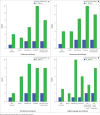Health and educational achievement of school-aged children: The impact of anaemia and iron status on learning
- PMID: 31934413
- PMCID: PMC6917415
- DOI: 10.4102/hsag.v24i0.1101
Health and educational achievement of school-aged children: The impact of anaemia and iron status on learning
Abstract
Background: Anaemia is a common blood disorder in children and is known to cause complications such as lethargy and stress on bodily organs. Children from disadvantaged communities often fail to achieve their age-related potential with iron deficiency anaemia stated as a risk factor through causing inattentiveness and learning problems. Limited evidence exists for the adverse effects of iron deficiency anaemia on the developing child's brain from South African studies.
Aim: The objective of this study was to determine the local prevalence of anaemia and iron deficiency and to examine their association with psychomotor development and school performance in school-aged children.
Setting: This study was conducted in a peri-urban disadvantaged community from KwaZulu-Natal, South Africa.
Methods: Children aged 6 to 8 years from KwaZulu-Natal were enrolled (n = 184). Three parameters of assessment were used: clinical data, biochemical data (haemoglobin levels and iron studies) and school performance (interviews with caregivers, teachers and the children). Anaemia presence and iron deficiency were the hypothesised mediating variables through which growth, development and school performance were influenced.
Results: A high point prevalence of anaemia (23.4%), iron deficiency anaemia (4.9%) and helminth infection (27.1%) was identified. Impaired cognitive assessment scores (20.7%) were prevalent in the children sampled. Behavioural problems (4.3%), poor memory function (4.3%) and impaired attention (1.1%) were of low prevalence. Anaemia and iron deficiency were both associated with impaired fine motor skills (p < 0.05). Anaemia was significantly associated with low cognitive scores (p = 0.01). Neither anaemia, iron status nor helminth infection significantly predicted school performance in the children sampled.
Conclusions: The point prevalence of anaemia and iron deficiency among the sampled children was higher than the national prevalence. The sample size was however inadequate for drawing statistical conclusions about psychomotor development and school performance because of the low prevalence of the different outcomes that were examined. Practical challenges faced in conducting this investigation in rural South African schools were discussed.
Keywords: anaemia; development; growth; iron status; school performance.
© 2019. The Authors.
Conflict of interest statement
The authors declare that they have no financial or personal relationships that may have inappropriately influenced them in writing this article.
Figures
Similar articles
-
Anaemia control and the interpretation of biochemical tests for iron status in children.BMC Res Notes. 2017 Apr 26;10(1):163. doi: 10.1186/s13104-017-2472-5. BMC Res Notes. 2017. PMID: 28441968 Free PMC article.
-
Anaemia and iron deficiency in peri-urban school children born in a National HIV Prevention Programme in Zimbabwe: A cross-sectional study.Cent Afr J Med. 2014 May-Aug;60(5-8):22-8. Cent Afr J Med. 2014. PMID: 26867252
-
Epidemiological evidence for a differential effect of hookworm species, Ancylostoma duodenale or Necator americanus, on iron status of children.Int J Epidemiol. 1998 Jun;27(3):530-7. doi: 10.1093/ije/27.3.530. Int J Epidemiol. 1998. PMID: 9698148
-
Home fortification of foods with multiple micronutrient powders for health and nutrition in children under two years of age.Cochrane Database Syst Rev. 2020 Feb 28;2(2):CD008959. doi: 10.1002/14651858.CD008959.pub3. Cochrane Database Syst Rev. 2020. PMID: 32107773 Free PMC article.
-
Prevalence of Anaemia, Iron Deficiency, and Iron Deficiency Anaemia in Women of Reproductive Age and Children under 5 Years of Age in South Africa (1997-2021): A Systematic Review.Int J Environ Res Public Health. 2021 Dec 4;18(23):12799. doi: 10.3390/ijerph182312799. Int J Environ Res Public Health. 2021. PMID: 34886524 Free PMC article.
Cited by
-
Dietary quality, anaemia prevalence and their associated factors among rural school- going adolescents in Acholi sub -region of Uganda.BMC Nutr. 2024 Dec 28;10(1):166. doi: 10.1186/s40795-024-00982-3. BMC Nutr. 2024. PMID: 39732695 Free PMC article.
-
Prevalence of Stunting and Relationship between Stunting and Associated Risk Factors with Academic Achievement and Cognitive Function: A Cross-Sectional Study with South African Primary School Children.Int J Environ Res Public Health. 2021 Apr 16;18(8):4218. doi: 10.3390/ijerph18084218. Int J Environ Res Public Health. 2021. PMID: 33923436 Free PMC article.
-
The effect of schistosomiasis and soil-transmitted helminths on expressive language skills among African preschool children.BMC Infect Dis. 2022 Mar 18;22(1):264. doi: 10.1186/s12879-022-07260-2. BMC Infect Dis. 2022. PMID: 35303827 Free PMC article.
-
Childhood Anemia in Mozambique: A Multilevel Mixed-Effects Analysis of 2011-2022/23 Population-Based Surveys.Healthcare (Basel). 2025 Mar 14;13(6):635. doi: 10.3390/healthcare13060635. Healthcare (Basel). 2025. PMID: 40150485 Free PMC article.
-
Prevalence and contributors to anaemia among children aged 6 to 59 months in Kyangwali Refugee settlement, Western Uganda: a cross-sectional study.BMC Pediatr. 2025 Jan 11;25(1):26. doi: 10.1186/s12887-024-05377-8. BMC Pediatr. 2025. PMID: 39799293 Free PMC article.
References
-
- Aboussaleh Y., Ahami A., El Hioui M. & Bonthoux F., 2009, Cognitive performance of anaemic school children, North-western Morocco, Micronutrient Forum Meeting, viewed 11 November 2015, from http://www.micronutrientforum.org/meeting2009/PDFs/Poster%20Presentation... O/F66-Aboussaleh.pdf
-
- Brooker S., Okello G., Njagi K., Dubeck M.M., Halliday K.E., Inyega H. et al. , 2010, ‘Improving educational achievement and anaemia of school children: Design of a cluster randomised trial of school-based malaria prevention and enhanced literacy instruction in Kenya’, BMC Trials 11, 93 10.1186/1745-6215-11-93 - DOI - PMC - PubMed
LinkOut - more resources
Full Text Sources


